Art World
‘Context Matters’: Christopher Wool on His Triumphant New Show in a Vacant Lower Manhattan Office Space
The point, says the artist, is to "create an environment where the work can play off the architecture."
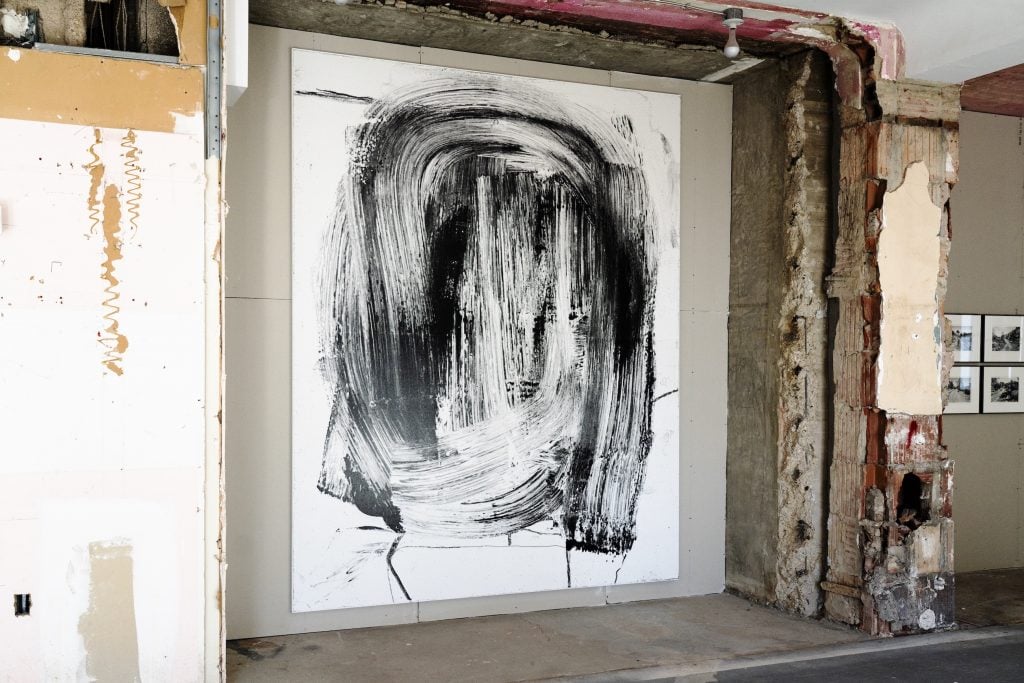
The point, says the artist, is to "create an environment where the work can play off the architecture."

Brian Boucher

Ever since the white-cube setting for fine art was conceived, artists have strived to break free of its strictures. A new exhibition by post-Modern artist Christopher Wool, taking place at a vacant and very raw lower Manhattan office space, adds a stellar new entry to a lengthy list. Some 72 pieces, mostly dating from the last several years and none for sale, are now on display in “See Stop Run,” on the 19th floor of a Financial District office tower.
The show runs until July 31. The artist’s quest for an atypical space started in January 2023. Wool and his curator, Anne Pontégnie, scoured the streets, first with the help of real estate brokers, then on their own. (They also had the help of the artist Rose Marcus and another associate.) The brokers were showing them spaces that were too glossy. Helping to narrow things down, they soon realized that ground-floor spaces smacked too much of retail, while residential spaces seemed too private. They also ruled out the neighborhoods of Chelsea and Tribeca because they didn’t want to appear among the art galleries, not wanting to be seen as a provocation to them.
They had their work cut out for them in surveying empty spaces; the island hit a record high office vacancy rate in 2023, with about 94 million square feet, or 17.4 percent, vacant. This emptiness is reminiscent of another one—the city was in a slump when Wool arrived in New York to attend art school in 1973. The metropolis remains wildly expensive despite the surge of vacancy and fallow acreage.
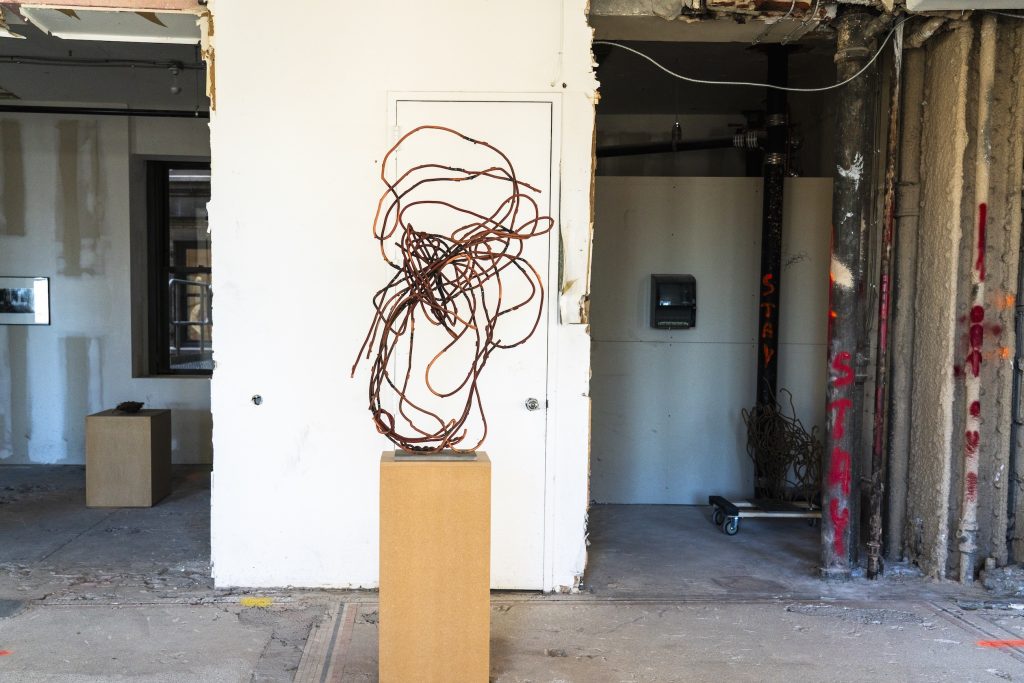
Christopher Wool’s exhibition “See Stop Run.” Courtesy of the artist.
The raw space is deeply attractive in its own right. Wires hang from the ceiling; areas of drywall have been punched out; graffiti is everywhere, some phallic, some in contractor language; work permits hang on the wall; floors are uneven. These features complement the rough qualities of Wool’s work.
Those works take the form of sculptures, prints, and photographs, almost all untitled. All exemplify a central characteristic of his work; as he puts it, “Each and every work in the exhibition is initiated in some sense by a reproduction of a previous work.”
Some are large abstractions with sweeping gestures and looping lines, others similar, smaller compositions. There are sculptures, some in copper-plated bronze, some in wire, that consist of tangled lines in space, resting on pedestals, sitting on the floor, or hanging from the ceiling. There’s a 16½-foot-wide mosaic with looping peach and black lines on a white-and-gray ground that is based on an untitled 2021 oil and inkjet on paper work that, perversely, is tucked away behind the mosaic. It’s his second mosaic after Crosstown Traffic, installed last year at the Manhattan West development.
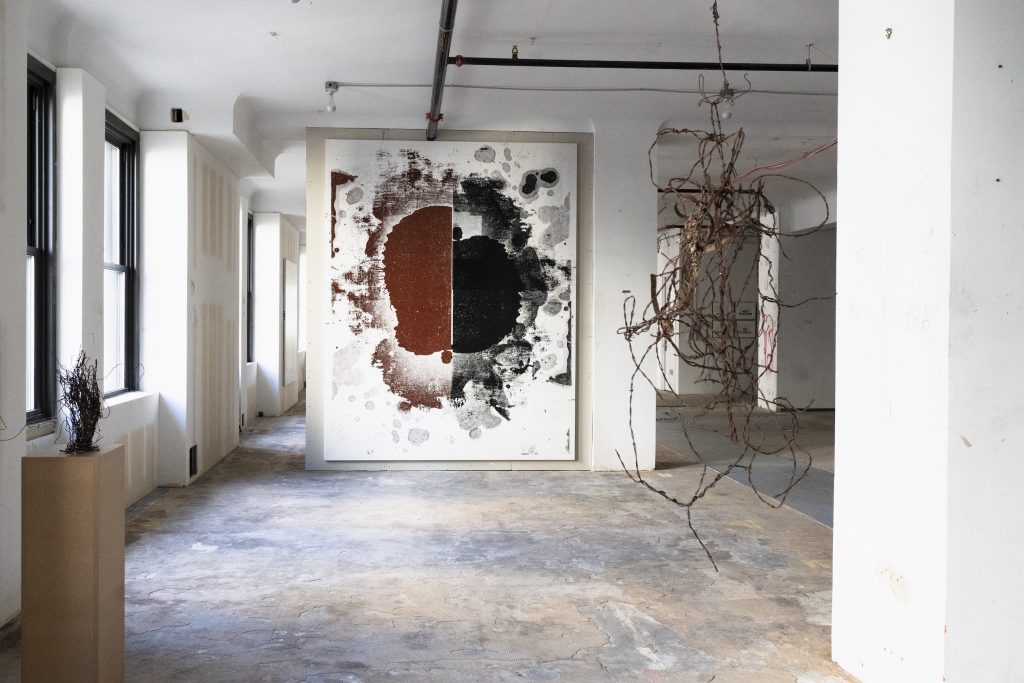
Christopher Wool’s exhibition “See Stop Run.” Courtesy of the artist.
The show comes a decade after the closing of a a retrospective at the Guggenheim, after which the artist, who is in his 60s, could have gracefully withdrawn into retirement. “See Stop Run” finds him opting for a new challenge, and one that he took on independent of his longtime gallery, Luhring Augustine.
Photographs are interspersed throughout, some from the dusty lands of West Texas, where he now has a home, some showing equally forlorn New York street scenes. A seating area offers books, some containing Wool’s photographs, and some, oversized, featuring lush reproductions of his painted and printed works.
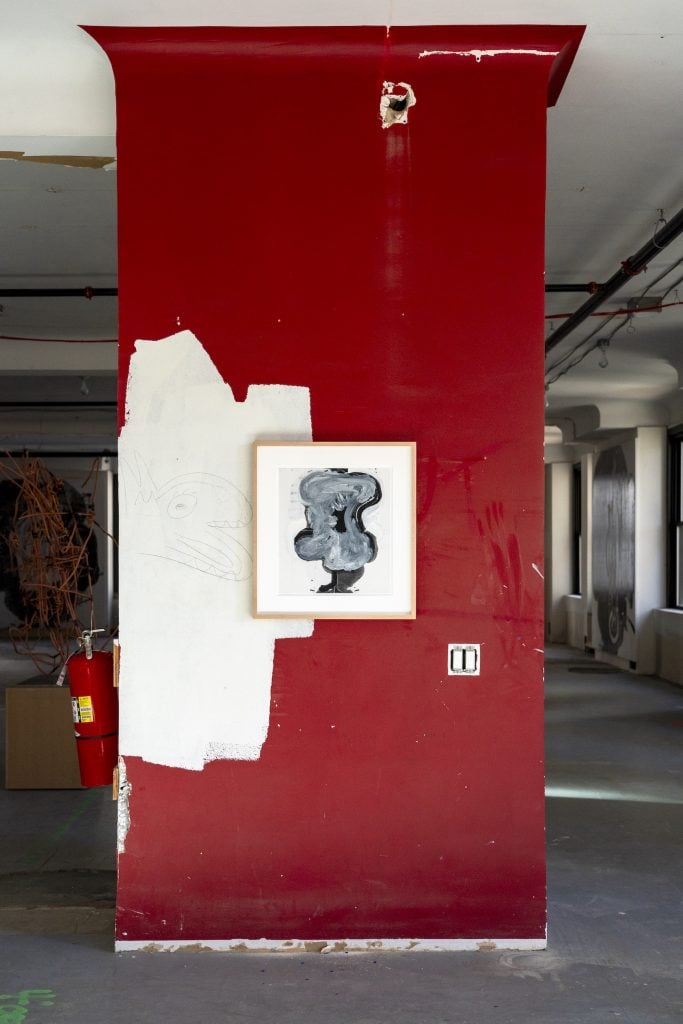
Christopher Wool’s exhibition “See Stop Run.” Courtesy of the artist.
Finding the space was challenging, but installation presented its own hurdles. The freight elevators weren’t big enough to accommodate the mosaic, which had to be brought up in sections, or some of the larger silkscreen-on-linen works, which measure up to 10 feet high and had to be removed from their stretchers. There was no HVAC and no sprinklers, as Curbed reported, and the works had to be insured, no small matter considering that the year after the Guggenheim show closed, Sotheby’s New York sold his 1990 painting Untitled (Riot) for some $29.9 million. (His market has dropped since then.)
The genesis of the project comes from time the artist spent in Marfa, Texas, where an artist from an earlier generation, Donald Judd, found disused space that he felt suited his work better than the customary gallery setting. Wool has owned a home there since 2007, having been invited to a residency there the year before, and when the artist came across castoff tangles of wire from fencing, he was inspired to create a new kind of sculpture, even finding some of the knotted barbed wires to be basically found artworks that he couldn’t improve on.
The survey’s title recalls his trademark text paintings, and is a transposition of “See Spot run,” a classic line from a children’s book. Just as the book helped kids learn to read, Wool’s text works—which are not always easily readable, with seemingly arbitrary line breaks and no spaces between words—seem to require the viewer/reader to see in a new way. The new exhibition, likewise, encourages us to view anew the supposedly neutral exhibition spaces that have become so standard, and ask whether they are the best kind of venue for art.
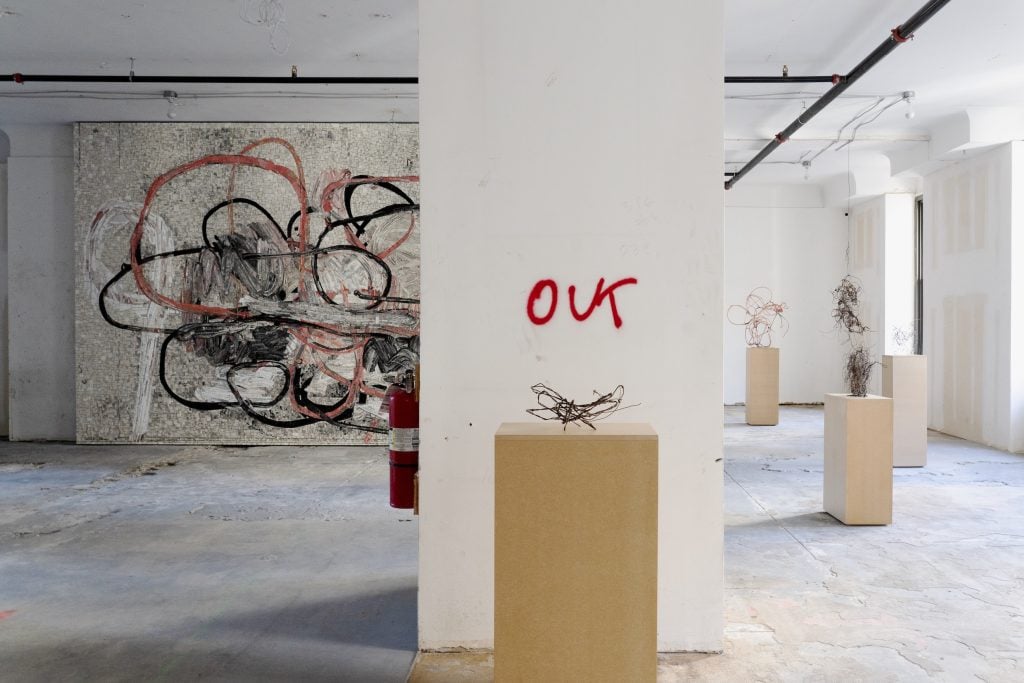
Christopher Wool’s exhibition “See Stop Run.” Courtesy of the artist.
Wool corresponded with us via email about translating ideas between mediums, the power of new settings, and a neglected masterpiece of public art. (At the artist’s request, the answers appear here exactly as emailed.)
One major strain in your work is the adaptation of a motif from one medium into another; can you tell me about one or two works from this show where a composition or an idea from one work is transmuted into another form, and describe what is gained through that process, for that work?
the mosaic is sourced from a work on paper that is in the exhibition…the paper work was a vertical turned 90 degrees to make the horizontal format… the copper plated cast sculptures come from small wire maquettes and the paintings sources are works on paper…several of these works on paper are integrated into the show….and there is a group of photos of many of the small wire works…almost everything in the exhibition has a link of some kind to something else in the exhibition….and the take away should be that so many of these different works are sourced in similar ways…making a large mosaic employs very similar means to what i do with silk screen or metal casting in painting and sculptures….this reuse across mediums creates new generations of images….
On a similar note, what does it mean to bring works that have their genesis in objects you found in wide-open Texas into the relatively claustrophobic confines of a New York office space? What does the contrast in scale and setting mean to you?
with 18,00 square feet and 42 windows its only claustrophobic compared to west texas… .one important idea for the show is that context matters…this poses the question can art be separated from its context?…
You searched all over the city for office space rather than picking this neighborhood, but does the location you found, where New York City was born and where you are surrounded by sites like the home of the former Twin Towers and the new World Trade Center Tower, the New York Stock Exchange, and Trinity Church, lend any particular resonance to the presentation?
for me the most resonant view from the building is of the harbor…reginald marsh spent many months sketching the harbor before painting his monumental and stunning ceiling frescos at customs house just a few blocks away….in my view these are examples of new yorks most outstanding public works…oddly somewhat forgotten…
In terms of the larger real estate context, Manhattan hit a record high of vacant office space in 2023, with about 94 million square feet, or 17.4 percent, empty. You arrived in New York in 1976, amid a real estate slump, one that was more visible during an economic downturn, whereas this vacancy is a little more shrouded, and the city remains fabulously expensive. Did visiting other potential venues for this show change the way you see the city?
not in any fundamental way…i’ve lived in the city for most of the last 50 years….of course we all wish we could go back in time…
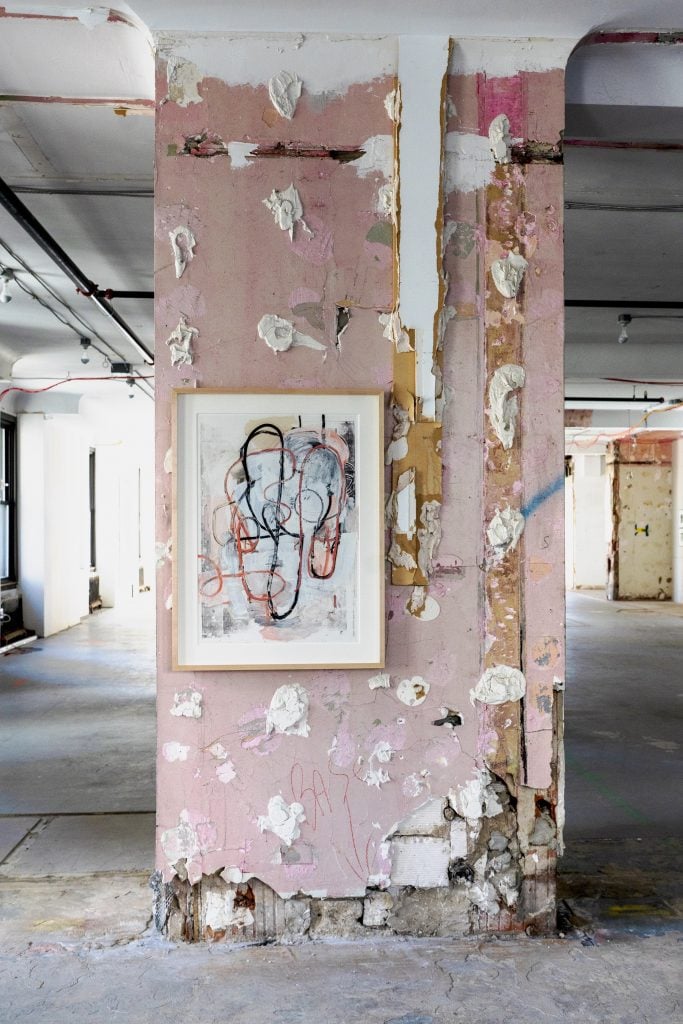
Christopher Wool’s exhibition “See Stop Run.” Courtesy of the artist.
Artists have frequently shown their work in non–white cube settings. Does this singular raw setting bring out characteristics of your work that white cube settings do not? Do you think you might be spoiled for conventional galleries or museums after this?
yes and maybe…the whole point of the installation is create an environment where the work can play off the architecture in ways that cant be done in a traditional gallery or museum….i’m sure this will have the potential to open other ideas…but there is no reason for me to think that this negates exhibiting in more traditional spaces…including the 2 paintings from the 90’s is a chance to see works that may have been exhibited in more traditional spaces in this alternative environment and i think its interesting to see how much the environment impacts how works are perceived….maybe its another example of the failures of the modernist ideal….
Your first mosaic project was the one you had installed at Two Manhattan West building, so your untitled one here is the second. What are you learning by working in this new medium? What’s the process like of translating the impulses from the oil and inkjet it’s based on into another, unfamiliar medium?
the 2 works were created at the same time…the instinct to look to mosaic as a way to make a monumental image came to me because the process is so similar to that of silk screen with one important caveat…they each involve a transformation to a dot matrix for enlargement…with silk screen reducing the image to dots while the mosaic process reduces the image to small tesseri ….but while the silk screen process is digital the mosaic process is basically analog …in a sense the mosaic fabricators are interpreting the image….placing the tessera by hand…somewhat like a composer and musician working together…i of course do my own silk screen printing so i am the interpreter in that process….with painting i’m playing my own compositions…with mosaic my compositions are being played by the fabricators…
Books are crucially important in your oeuvre. How would you describe the role of the books in this particular presentation?
books are just one of the mediums present in the show that all tie into each other…almost all of the other medium’s source materials are presented in books….to make a terrible pun the books bind all of the other material together….forgive me…
Christopher Wool’s “See Stop Run” is on view on the 19th floor of 101 Greenwich Street through July 31, 2024.